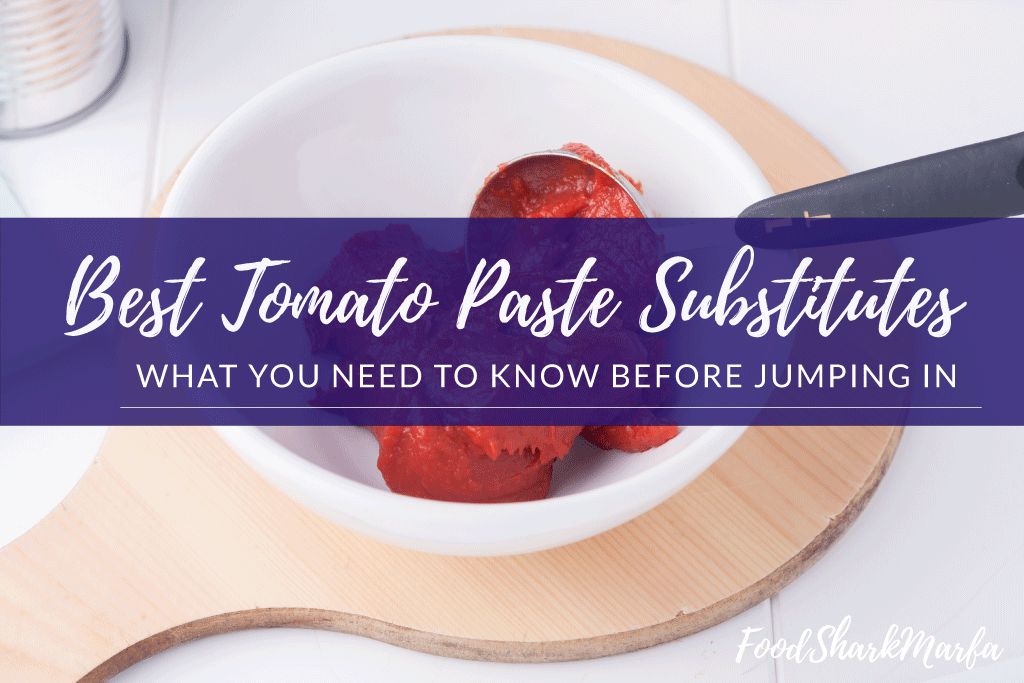No one can deny the brilliant flavor and impressive versality of tomato paste. Even those who don’t like raw tomatoes often can’t resist that delicious tangy flavor it brings to so many dishes.
But sadly, sometimes our tomato paste stocks have run dry or our allergies prevent us from enjoying everything it has to offer. For these testing times of tomato paste drought, we’ve comprised a list of the top 7 tomato paste substitutes with a variety of benefits to suit your own specific needs.
What is tomato paste?
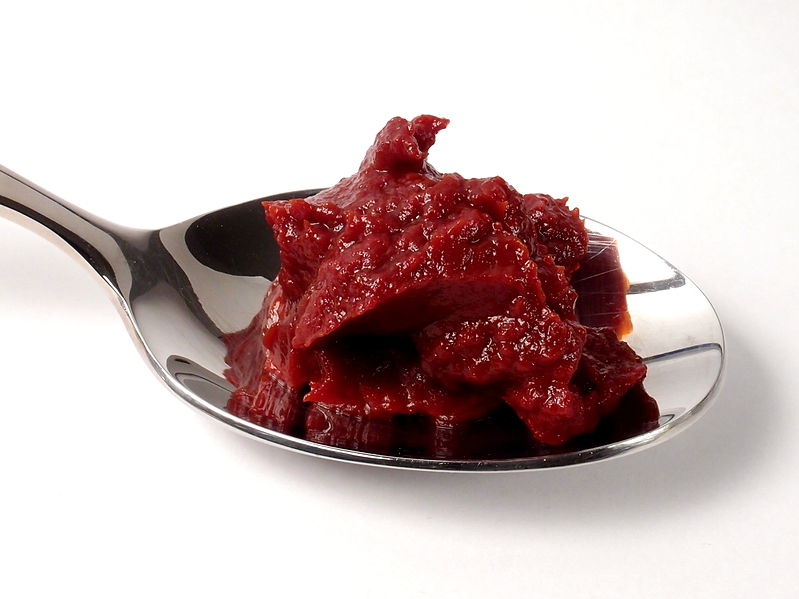
Tomato paste, also called tomato purée in the UK, is pretty self-explanatory. It is a thick paste created from tomatoes that have been cooked, strained of seeds and skins and then cooked again to further reduce the water content. It differs from tomato purée (in the American sense) and tomato sauce in its consistency and sometimes its ingredients.
While tomato sauce often contains additives, tomato paste and purée usually just consist of cooked tomatoes. Tomato purée is thicker in consistency than tomato sauce and tomato paste is thicker than tomato purée, making it the thickest of the three forms.
Because tomato paste is so concentrated, even a small spoonful contains a whole lot of that rich, tangy flavor we know and love. Tomato paste has been commercially available for over a century and has been a popular, widely used ingredient ever since.
How healthy (or unhealthy) is it?
If you love tomato paste, you’ll be happy to hear that it comes with a variety of health benefits. As well as being low in calories (just 82 calories per 100g) and containing next to no fat, tomato paste also contains many essential vitamins and minerals.
100g of tomato paste contains 16% of your daily recommended iron, 28% of your potassium, 30% of your vitamin A, 36% of your vitamin C and 10% of your vitamin B-6. But wait, there’s more! Tomato paste also contains antioxidants that can help prevent cancer and other diseases. It also has protective properties that can help provide protection from sunburn.
Nutritional Breakdown:
Tomato paste | Amount (per 100 g) | % Recommended daily intake |
Calories | 82 kcal | 4 % |
Total fat | 0.5 g | 0 % |
Saturated fat | 0.1 g | 0 % |
Cholesterol | - | 0 % |
Salt | 59 mg | 2 % |
Protein | 4.3 g | 8 % |
Calcium | 30 mg | 3 % |
Iron | 3 mg | 16 % |
Potassium | 1,014 mg | 28 % |
Vitamin A | 1,525 IU | 30 % |
Vitamin C | 22 mg | 36 % |
Vitamin B-6 | 0.22 mg | 10 % |
(Based on nutritional information from USDA on tomato paste.)
What recipes are tomato paste used in?
Tomato paste is a highly versatile ingredient that can be used in all kinds of recipes, from sauces and soups to chilis, stews, and even ketchup! Thanks to its highly concentrated flavor, a little tomato paste goes a long way.
Most recipes will only call for a tablespoon or two at most, but that will be more than enough to enrich your dish with a deep, rich tomato flavor. The other great thing about tomato paste is that its low water content (in comparison to tomato purée or tomato sauce) means you can add it to recipes containing a lot of other liquid ingredients without making it overly runny.
Why do we need tomato paste substitutes?
Despite how nutritious, convenient and versatile tomato sauce can be, there are a few reasons why one may still need to seek out a substitute. One downside of canned tomato paste is that recipes will usually only call for a very small amount of tomato paste, meaning that much of it often goes to waste unless you can find other uses for it within just a few days. In this sense, convenience can be an issue if you’re having to go out and buy a new can every time you plan on adding tomato paste to your dish.
Secondly, some of us are afflicted with allergies and adverse reactions that prevent us from enjoying the delicious flavors tomato paste has to offer. Because tomato paste is used in so many popular dishes, it can be a real nuisance to find good alternatives without compromising on flavor or consistency. But not to worry – no matter what your specific reasons and needs are, this list is sure to have a substitute for you. So without further ado, let’s take a look at our top 7 tomato paste substitutes.
Note:
🌱 = vegan
🥛 / 🌱 = dairy and vegan options1. Tubed tomato paste 🌱
Best for: soups, sauces, chili, stews and more
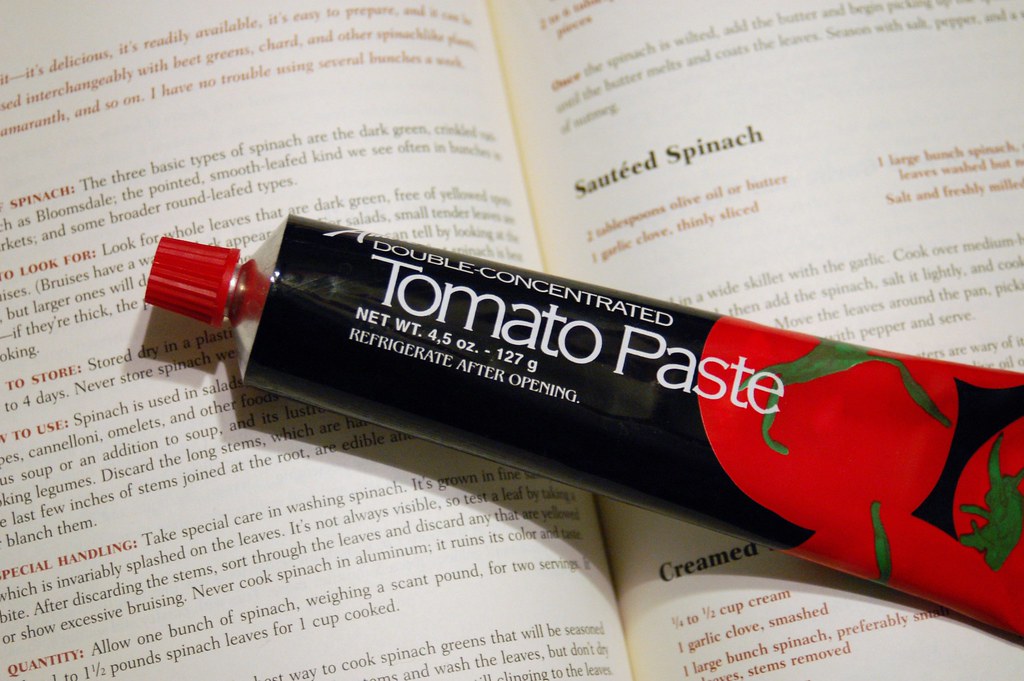
Okay, this isn’t a tomato paste substitute per se, but it’s definitely worth considering if your main problem is the inconvenience of cracking open a fresh can of tomato paste every time you need to use just a little spoonful or two. Tubed tomato paste lasts much longer than canned tomato paste, making it a much more convenient option.
Advantages
Now if your main reason for searching for tomato paste substitutes is the inconvenience of the can it comes in, then look no further. Tubed tomato paste has all the goodness and tangy flavor of canned tomato paste, but with the convenience of a resealable tube.
Because a tube is much more airtight than an opened can, the tomato paste inside will last much longer without going bad. Most tubed tomato paste brands advise that it will last about 45 days in the fridge once opened, but many tube-enthusiasts report that it stays good for many months more. This makes it far more convenient than canned tomato paste, which typically only lasts less than a week once opened.
Another great thing about tubed tomato paste is that, well, it’s still tomato paste. There are no suspicious additives or preservatives that make tubed tomato paste last longer than canned tomato paste; it’s all in the power of the airtight tube. This means that you get that same great taste of canned tomato paste with less of the hassle.
Disadvantages
While this is a great substitute if convenience is your main gripe with tomato paste, it’s obviously not so great if you’re either allergic to tomatoes or just want to grab something from your pantry to use instead. Tubed tomato paste can be a little harder to find than the canned stuff, especially in the USA, but it’s definitely out there. If you can’t find any in your local stores, there are plenty of online options available.
You typically won’t get as much tomato paste in a tube as you would in a can. However, this could equally be considered an advantage if you find yourself using a tiny amount every time you cook.
Nutritional breakdown
Double concentrate tubed tomato paste | Amount (per 100 g) | % Recommended daily intake |
Calories | 120 kcal | 6 % |
Total fat | - | 0 % |
Saturated fat | - | 0 % |
Cholesterol | - | 0 % |
Salt | 70 mg | 3 % |
Protein | 6 g | 11 % |
Calcium | 21 mg | 2 % |
Iron | 1 mg | 4 % |
Potassium | 410 mg | 8 % |
(Based on nutritional information for Cento Tomato Paste in a Tube.)
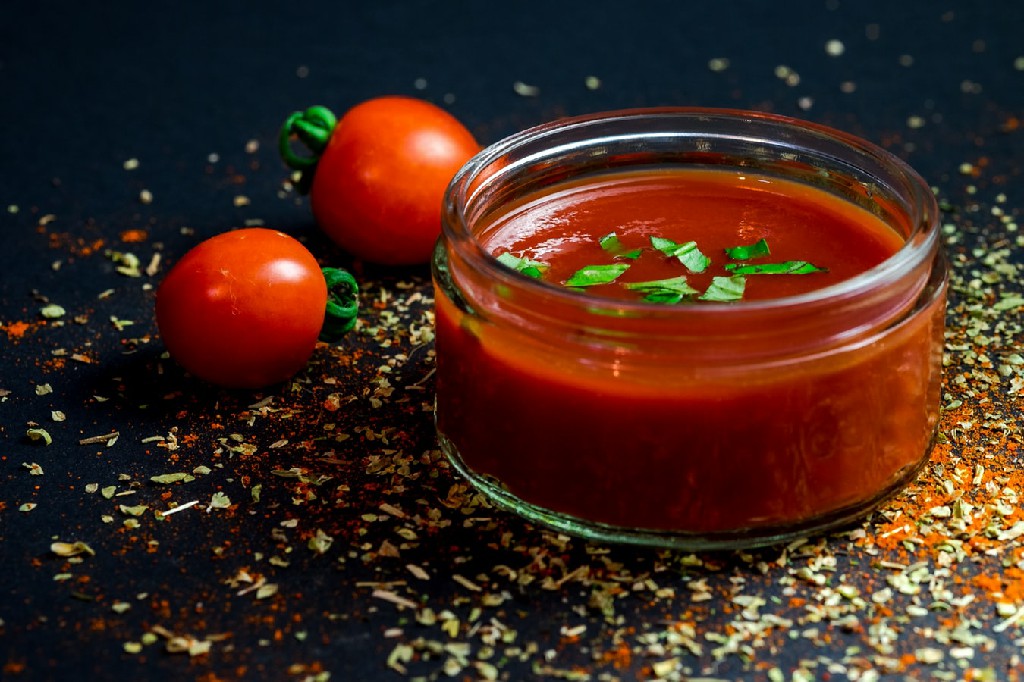
Tomato purée is essentially a thinner, less concentrated form of tomato paste, making it a great alternative if you’re in a pinch and need something you can grab from your pantry without needing to run to the store.
For best results, substitute 1 tablespoon of tomato paste for 2-3 tablespoons of tomato purée and reduce the amount of other liquid ingredients in your recipe by 2-3 tablespoons accordingly.
Advantages
Just like tomato paste, tomato purée is made from cooked and strained tomatoes. The only difference is that tomato paste is cooked for longer in order to further thicken and concentrate the consistency and flavor.
Because both are made from tomatoes and created in very similar ways, the flavor is about as close as you can get to the real thing. Tomato purée isn’t as strong as tomato paste, but you can simply use 2-3x the amount and reduce the amount of other liquid ingredients accordingly. Once combined with your other ingredients, you’ll barely be able to notice the difference in your dish.
Another great thing about tomato purée is that its health benefits will be almost identical to those of tomato paste. Yes, tomato purée is less concentrated and therefore contains fewer vitamins and minerals per teaspoon, but if you’re using more tomato purée than you would tomato paste anyway, then this won’t be an issue.
Finally, just like tomato paste, tomato purée is almost exclusively vegan, making it a viable option if you’re on a plant-based diet.
Disadvantages
The key difference between tomato paste and purée is their consistency and flavor. Because tomato purée is less concentrated and thick than tomato paste, it will not produce exactly the same results if used in the same way.
The flavor of tomato purée is not as concentrated or intense as tomato paste and it creates more of a liquid consistency. However, you can get around these issues by adding more tomato purée than the amount of paste called for by your recipe and reducing the amount of other liquid ingredients.
We recommend using 2-3 tablespoons of tomato purée for every 1 tablespoon of tomato paste called for by your recipe. To ensure the consistency isn’t affected, simply reduce the amount of other liquid ingredients in your dish by 2-3 tablespoons.
Obviously, tomato purée contains tomatoes just like tomato paste, so this doesn’t make a good option if you’re allergic or are trying to get away from that distinctive tomato taste.
Nutritional breakdown
Tomato purée | Amount (per 100 g) | % Recommended daily intake |
Calories | 38 kcal | 2 % |
Total fat | 0.2 g | 0 % |
Saturated fat | - | 0 % |
Cholesterol | - | 0 % |
Salt | 28 mg | 1 % |
Protein | 1.7 g | 3 % |
Calcium | 18 mg | 1 % |
Iron | 1.78 mg | 9 % |
Potassium | 439 mg | 12 % |
Vitamin A | 510 IU | 10 % |
Vitamin C | 10.6 mg | 17 % |
Vitamin B-6 | 0.13 mg | 5 % |
3. Tomato sauce 🌱
Best for: soups, sauces and stews
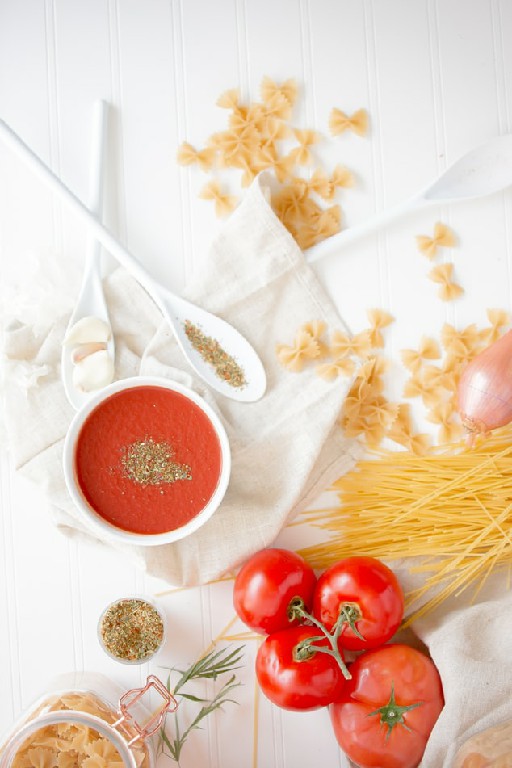
Tomato sauce isn’t quite as good of a substitute as tomato purée because it’s thinner and often contains additional ingredients. However, because the flavor and makeup is still largely the same, it can make a decent substitute if nothing better is available. For best results, substitute 1 tablespoon of tomato paste for 2-3 tablespoons of tomato sauce and reduce the amount of other liquid ingredients in your recipe by 2-3 tablespoons accordingly.
Advantages
Although tomato sauce is thinner than both tomato paste and tomato purée, it’s still created in a similar way and consists mostly of tomatoes, meaning that its flavor is still very similar to that of tomato paste. It may make your dish slightly thinner than if you had used the same amount of tomato purée, but it won’t be anything too noticeable if you’re only using a small amount.
If you’re not a fan of that intensely tangy taste of pure tomato paste, then using a tomato sauce that contains other ingredients and flavors could be a good option for you. Many tomato sauces use oils, red peppers and other vegetables to create a unique flavor that many will prefer to pure, unadulterated tomato sauce. Simply check the label to make sure the flavor combination is right for your tastes.
Disadvantages
However, if you want something that tastes as much like tomato paste as possible, the additional flavors that are often added to tomato sauce can be considered a disadvantage.
Tomato sauces are often created to be used on their own without the need of additional ingredients, giving them a more balanced but less tomatoey flavor. Of course, this is still a more convincing option than substitutes that contain no tomatoes, but be aware that the flavor may be significantly different from that of tomato paste if other ingredients are included.
The health benefits and drawbacks of tomato sauce can vary greatly depending on the variety. Some sauces may contain high amounts of oil, additives or preservatives, so be sure to check the label to make sure your body doesn’t get any nasty surprises.
Vegans should also be wary of whether the added ingredients are 100% vegan or not. While many tomato sauce varieties are totally dairy and meat free, it’s always worth checking the label to be sure.
You won’t be surprised to hear that like tomato paste and purée, tomato sauce isn’t a good option for those with a tomato allergy.
Nutritional breakdown
Tomato sauce | Amount (per 100 g) | % Recommended daily intake |
Calories | 29 kcal | 1 % |
Total fat | 0.2 g | 0 % |
Saturated fat | - | 0 % |
Cholesterol | - | 0 % |
Salt | 11 mg | 0 % |
Protein | 1.3 g | 2 % |
Calcium | 14 mg | 1 % |
Iron | 0.96 mg | 5 % |
Potassium | 331 mg | 9 % |
Vitamin A | 435 IU | 8 % |
Vitamin C | 7 mg | 11 % |
Vitamin B-6 | 0.1 mg | 5 % |
4. Make your own paste 🌱 (chopped or canned tomatoes)
Best for: soups, sauces, stews, chili and more

Have tomatoes but no paste? Then why not try making your own? This substitute does take some time and work, but it also produces delicious results that can be even better than the premade stuff. There are several different methods one can use to make tomato paste, so find your favorite by searching online, or simply use this one.
Advantages
Our favorite thing about this substitute is that you can use whatever tomatoes you want to make your paste. No matter whether you want to make a delicious, high quality paste with fresh, organic tomatoes or use whatever leftover tomatoes you have lying around, this substitute will work for you.
However, do keep in mind that the quality of your tomato paste will primarily depend on the quality of your tomatoes. For best results, you’ll want to use the meatiest, highest quality tomatoes you have available.
Homemade tomato paste can also be even more delicious than the canned or tubed stuff, especially if you’re using high quality tomatoes. But even if you’re using bog-standard leftover tomatoes you have lying around, you’re sure to get a great substitute that’s just as good as the premade kind.
This substitute is also great because it’s typically significantly cheaper than buying premade tomato paste. By making your own paste, you’re cutting out the time and labor costs that you’re paying for in the premade kind.
Homemade tomato paste can also last up to 4 weeks in the fridge if stored correctly (using jars is a great option), or up to 9 months in the freezer.
Lastly, as long as you don’t add any non-vegan extras into the mix, this substitute is 100% vegan.
Disadvantages
Although making your own tomato paste isn’t too challenging, it does take some time and effort. Homemade tomato paste will usually take at least 3-4 hours to produce, meaning that it’s not a great option if you’re in a rush or don’t have the time to spare.
Once again, this substitute obviously isn’t an option to those allergic to tomatoes.
Nutritional breakdown
Tomatoes | Amount (per 100 g) | % Recommended daily intake |
Calories | 18 kcal | 1 % |
Total fat | 0.2 g | 0 % |
Saturated fat | - | 0 % |
Cholesterol | - | 0 % |
Salt | 5 mg | 0 % |
Protein | 0.88 g | 1 % |
Calcium | 10 mg | 1 % |
Iron | 0.27 mg | 2 % |
Potassium | 237 mg | 6 % |
Vitamin A | 833 IU | 15 % |
Vitamin C | 13.7 mg | 22 % |
Vitamin B-6 | 0.08 mg | 4 % |
5. Tomato ketchup 🌱
Best for: soups and sauces
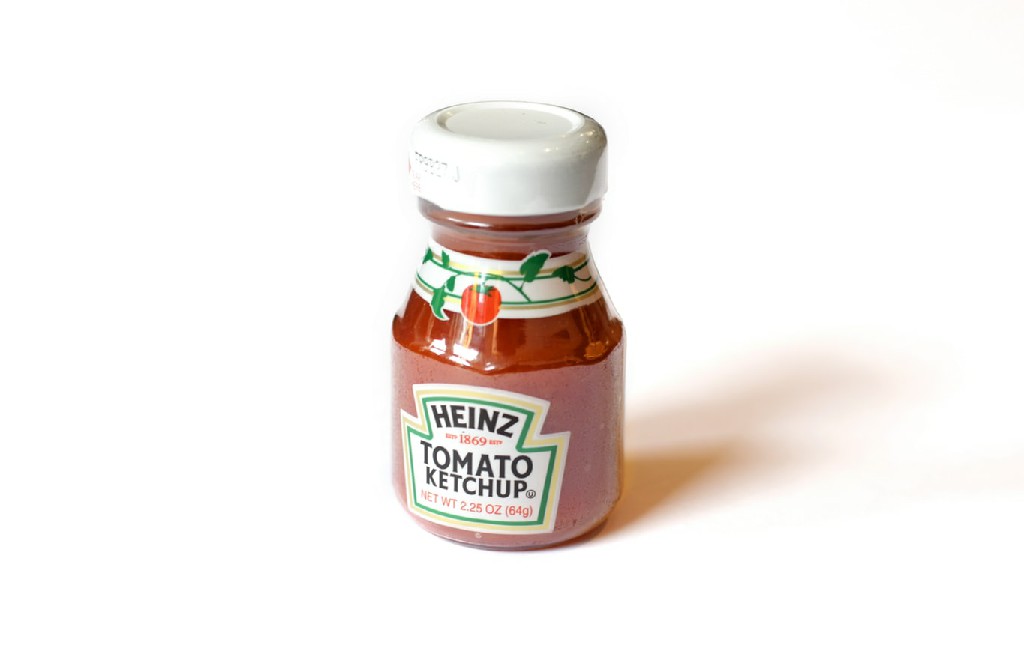
This isn’t the ideal substitute because its flavor is so different from that of tomato paste and it’s also much thinner in consistency. However, if it’s all you’ve got to work with, it still makes an acceptable substitute. To use, substitute 2 tablespoons of ketchup for every 1 tablespoon of tomato paste called for by your recipe.
Advantages
Although tomato ketchup is significantly more sugary than tomato paste and contains several additional ingredients, it still retains that tomatoey flavor. While you will be able to taste the difference between the two, it won’t be too noticeable if you’re only using a small amount and you’re working with a lot of different ingredients.
While the flavor might not be all there, the convenience certainly is. Many of us will have a bottle of ketchup sitting around in our pantry or fridge, making it super easy to use when you’re in a pinch. Ketchup is also incredibly convenient because of how long-lasting it is. An opened bottle of ketchup can last an impressive 12 months in the fridge – much longer than a can or tube of tomato paste. This is because the sugar, vinegar, acidity and other preservatives in ketchup keep it good for long periods of time.
Tomato ketchup is also vegan, making it an equally good option for vegans in need of a quick and easy substitute.
Disadvantages
But unfortunately, ketchup can never live up to the thick, tangy goodness of tomato paste. Ketchup is both much thinner than tomato paste and contains many additional ingredients that make the flavor more sugary than the tangy intensity of the real stuff. If you don’t mind the difference in flavor, this still works as an acceptable substitute, but you may want to consider another option if you’re going for that authentic tomatoey taste.
Unlike tomato paste, ketchup really isn’t the healthiest thing in the world. Containing 22g of sugar and 907mg of salt per 100g, this isn’t the best choice if you’re health conscious or on a diet. It does still contain a high percentage of tomatoes and therefore contains some of the same vitamins and minerals as tomato paste, but not half as much.
Although ketchup contains a lower percentage of tomatoes than the other tomato products on our list, it’s still no good for those of us allergic to tomatoes.
Nutritional breakdown
Tomato ketchup | Amount (per 100 g) | % Recommended daily intake |
Calories | 112 kcal | 5 % |
Total fat | 0.2 g | 0 % |
Saturated fat | 0.1 g | 0 % |
Cholesterol | - | 0 % |
Salt | 907 mg | 37 % |
Protein | 1.3 g | 2 % |
Calcium | 15 mg | 1 % |
Iron | 0.35 mg | 2 % |
Potassium | 315 mg | 9 % |
Vitamin A | 527 IU | 10 % |
Vitamin C | 4.1 mg | 6 % |
Vitamin B-6 | 0.16 mg | 10 % |
6. Red bell peppers / red pepper paste 🌱
Best for: soups, sauces and stews
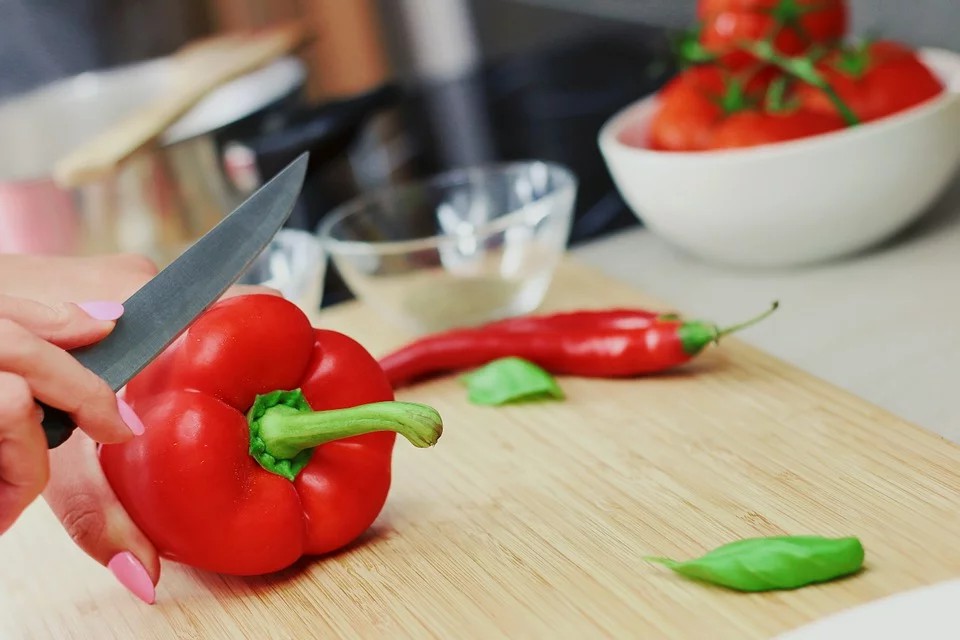
Bell peppers may seem like a strange substitute for tomato paste at first, but hear us out. If you’re allergic to tomatoes or simply aren’t a fan of the taste, red pepper paste can be a great option. It provides the same thickness of tomato paste with a whole different flavor. If you like bell peppers, this could be the one for you. To use, either buy a premade red pepper paste, or make your own by chopping up and deseeding red bell peppers, blending in a food processor/blender and then cooking to reduce to your desired consistency.
Advantages
This is a great option if you’re allergic to tomatoes or don’t enjoy the flavor of tomato paste. Red pepper paste has a sweeter, milder flavor than tomato paste and contains no traces of tomato (unless you choose to include them).
Because the consistency of red pepper paste is so similar to that of tomato paste, you can usually use a 1:1 substitution ratio. This is great for keeping the same consistency of your dish without the hassle of changing the amounts of other ingredients.
You’re also not losing out health-wise with this substitute. Red peppers are extremely nutritious, with 62% of your daily recommended vitamin A, 212% of your vitamin C and 15% of your vitamin B-6 per 100g.
Red pepper paste is also 100% vegan if you make it yourself or buy a premade variety without too many additional ingredients, making it a great option for most dietary needs.
Disadvantages
Because this substitute uses red peppers and no tomatoes (unless you go for a paste that also contains tomatoes), it will not have the same flavor as tomato paste. As stated above, this is a great thing if you’re not keen on the tangy taste of tomato paste, but it’s not so great if you’re going for something as similar as possible without using the real thing. However, if you want to go for a bit more of a tangy, acidic flavor, you can always add a splash of vinegar or lemon juice to the mix.
Premade red pepper paste can be a little tricky to find if you live in the West. You can try your luck at the international aisles, but it’s often an easier option to buy online.
If you decide to make your own, it will take some time to deseed, chop, process and cook the peppers, so this isn’t a great option if you don’t have much time to spare.
Nutritional breakdown
Red bell peppers | Amount (per 100 g) | % Recommended daily intake |
Calories | 26 kcal | 2 % |
Total fat | 0.3 g | 0 % |
Saturated fat | - | 0 % |
Cholesterol | - | 0 % |
Salt | 4 mg | 0 % |
Protein | 1 g | 2 % |
Calcium | - | 0 % |
Iron | 0.43 mg | 3 % |
Potassium | 211 mg | 6 % |
Vitamin A | 3131 IU | 62 % |
Vitamin C | 127.7 mg | 212 % |
Vitamin B-6 | 0.3 mg | 15 % |
7. Salsa verde 🌱
Best for: soups and sauces
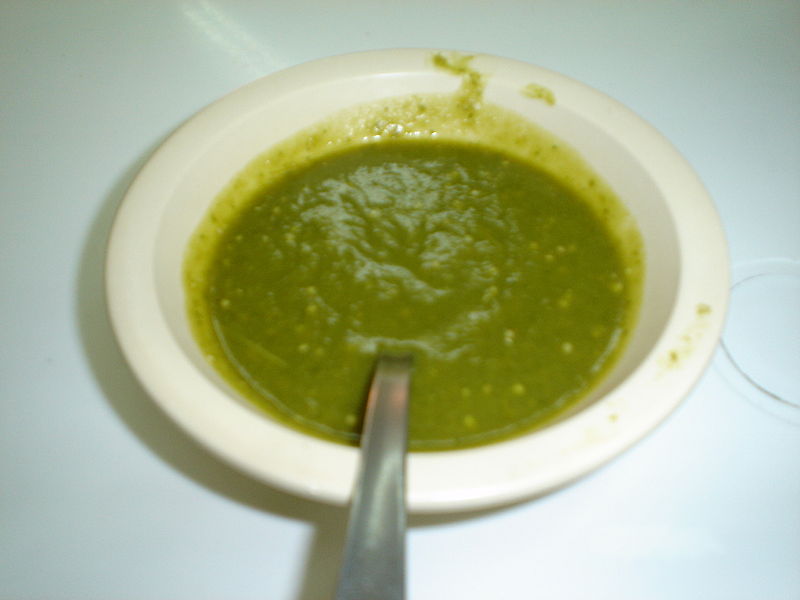
If you’re not familiar with salsa verde, you’re missing out! Salsa verde is a tasty Mexican salsa primarily made from tomatillos and green chili peppers. If you’re allergic to tomatoes but not tomatillos, this could be the one for you.
Tomatillos are more acidic and not quite as sweet as red tomatoes, but are similar in flavor overall. To use, substitute 2-3 tablespoons of salsa verde for every 1 tablespoon of tomato paste called for by your recipe. Reduce the amount of other liquid ingredients by 2-3 tablespoons accordingly.
Advantages
Salsa verde is primarily made from tomatillos, which are pretty similar in flavor to tomatoes. Tomatillos are slightly more acidic and less sweet than tomatoes, so you will notice a difference in flavor, but nothing too noticeable when used in a recipe with many other ingredients. For a flavor most similar to that of tomato paste, go for a variety with lower amounts of green chili pepper and higher amounts of tomatillos.
Although salsa verde doesn’t taste exactly like tomato paste, it’s still a great option for those who are allergic to tomatoes and want something as close as possible to the real thing. However, as tomatillos are a close relative of tomatoes, it is important to make sure that your tomato allergy doesn’t stem to tomatillos.
Disadvantages
Although salsa verde does come pretty close to the flavor of tomato paste, it’s not quite the same. Tomatillos are more acidic and less sweet than normal tomatoes, which affects the flavor of the salsa accordingly.
The addition of green chili peppers also adds a bit of a spicy kick to the mix, which may not be what you’re looking for in your dish. However, the heat won’t be too much of an issue, as green chilis are only a 2 or 3 on the Scoville scale, with 10 being the hottest. Still, if you’re not allergic to tomatoes, you may want to use an option with a closer flavor match.
Although salsa verde contains a reasonable amount of vitamin C and some other vitamins and minerals, it isn’t as nutritious as tomato paste and usually contains significantly more salt. Be sure to check the label to make sure
Salsa verde can be a little difficult to find in your local grocery store. You can either take a look in the international and sauce aisles, or invest in an online option to save yourself the trouble of going out to the store.
Nutritional breakdown
Salsa verde | Amount (per 100 g) | % Recommended daily intake |
Calories | 38 kcal | 2 % |
Total fat | - | 0 % |
Saturated fat | - | 0 % |
Cholesterol | - | 0 % |
Salt | 600 mg | 25 % |
Protein | 1.1 g | 2 % |
Calcium | 9 mg | 0 % |
Iron | 0.65 mg | 3 % |
Potassium | 259 mg | 7 % |
Vitamin A | 217 IU | 4 % |
Vitamin C | 12.3 mg | 20 % |
Vitamin B-6 | 0.08 mg | 5 % |
The Bottom Line
So, there you have it: 7 convenient, delicious and nutritious tomato paste substitutes. But before we leave you, let’s take one last look at a summary of our top picks for tomato allergies, health, convenience and similarity to tomato paste.
Top picks for tomato allergies
Red pepper paste and salsa verde are both great options for those of you suffering from a tomato allergy. Salsa verde will taste more like the real stuff, if slightly more acidic and less sweet. Red pepper paste won’t have the same flavor as tomato paste, but makes a great option if you’re not a big fan of tomato paste anyway.
Top healthy picks
Tomato paste is nutritious and low in calories, so it’s not really necessary to substitute it purely for health reasons (unless you’re allergic, of course). However, tomato purée, many tomato sauces and red pepper paste are all nutritious options that contain many of the same vitamins and minerals as tomato paste.
Top convenient picks
While tubed tomato paste isn’t exactly a tomato paste substitute, it is a highly convenient alternative to the canned variety. Tubed tomato paste can last over 45 days in the fridge once opened, whereas canned tomato paste typically lasts less than a week.
Tomato ketchup is another convenient option as many of us always have a bottle sitting around somewhere, and it seems to last forever. But do keep in mind that ketchup is not as healthy as tomato paste and the flavor will be noticeable different.
Making your own tomato paste can also be a convenient option if you already have some tomatoes that need using up. However, it does take a few hours to make, so it’s not such a good option if you’re short on time.
Top convincing picks
Naturally, making your own tomato paste or using a tubed variety will be your best options if you want an exact flavor and consistency match. Using meaty, high quality tomatoes to make your own can give you even better flavor results than the premade stuff.
If you have tomato purée or tomato sauce available, these substitutes can also make very convincing alternatives. Just remember to use 2-3x the amount of tomato paste called for by the recipe and reduce the amount of other liquid ingredients accordingly. This will ensure that you get a deep, tomatoey flavor without compromising on consistency.
